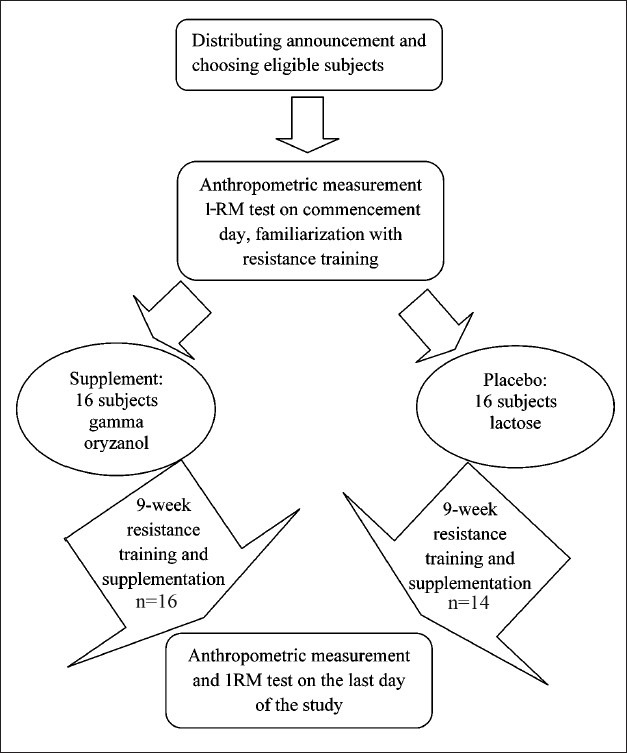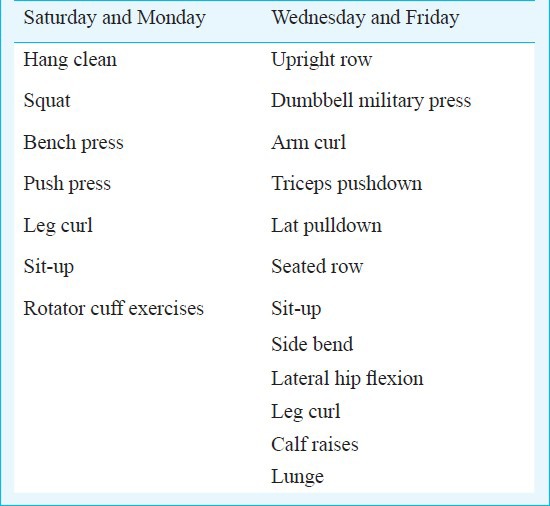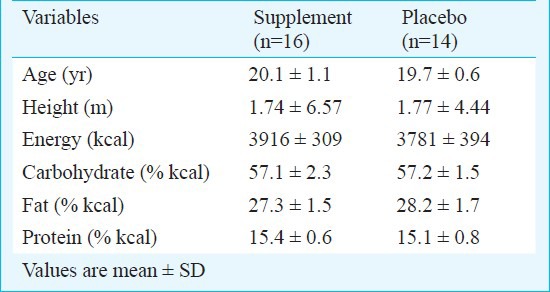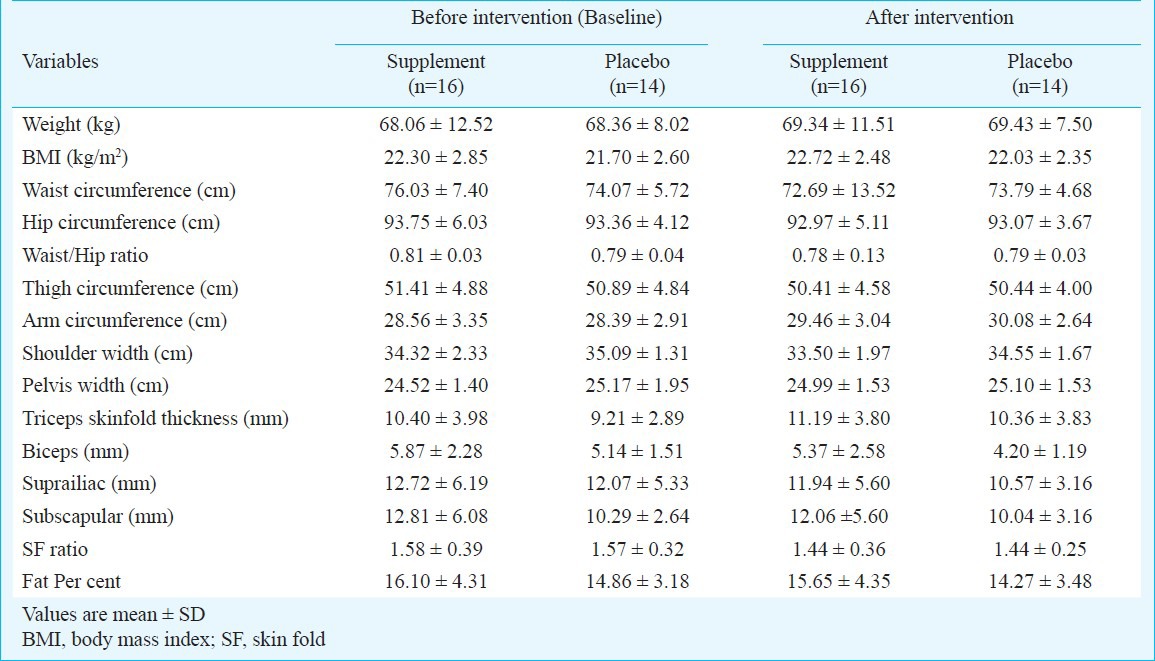Abstract
Background & objectives:
Enhanced muscle strength is seen when resistance exercise is combined with the consumption of nutritional supplements. Although there is a limited number of studies available about the efficacy of gamma oryzanol supplementation with resistance exercise in humans, but its usage as a nutritional supplement for strength is common in athletes. The aim of this study was to determine the effects of gamma oryzanol supplementation during 9-week resistance training on muscular strength and anthropometric measurements of young healthy males.
Methods:
In this double-blind clinical trial, changes of anthropometric measurements and muscular strength were studied after chronic resistance exercise and gamma oryzanol supplementation in 30 healthy volunteers (16 in supplement and 14 in placebo). Each day, gamma oryzanol supplement (600 mg) and placebo (the same amount of lactose) were consumed after training. The participants exercised with 80 per cent 1-Repetition Maximum (1-RM), for one hour and four days/week. Anthropometric measurements and subjects’ 1-RM for muscular strength were determined at the commencement and end of the 9-week study.
Results:
There was no significant difference between the baseline characteristics and target variables at baseline between the two groups. After gamma oryzanol supplementation, there was no significant difference in the means of anthropometric and skin fold measurements between the supplement and placebo groups. However, there were significant differences between the supplement and placebo groups for 1-RM of bench press and leg curl, which showed that gamma oryzanol improved muscle strength following resistance training.
Interpretation & conclusions:
Our findings indicated that 600 mg/day gamma oryzanol supplementation during the 9-week resistance training did not change anthropometric and body measurements, but it increased muscular strength in young healthy males. Further, studies need to be done in trained athletes, women, and in patients who suffer from muscular fatigue.
Keywords: Anthropometric, body measurements, gamma oryzanol, muscular strength, resistance training
Many of the factors which affect maximum strength capacity of skeletal muscle, work in a synergistic manner. The most powerful factor is resistance training, which impressively rises maximal isometric and dynamic muscle contraction strength1. Resistance training (also named weight or strength training) is identified by the performance of exercises in which muscles from a particular body part are condensed against a power that opposes the movement2,3.
It is known now that the use of nutrient intake positively influences sport performance4. Products which claim to extend endurance, increase recovery, decrease body fat, increase muscle mass, reduce the risk of illness, or achieve other goals that improve sports performance, have filled the sports world5. Many competitive and recreational athletes have tended to consume dietary supplements to intensify strength training and performance6.
Herbal dietary supplements are introduced to physically active subjects for numerous reasons, involving increasing energy, bringing about weight loss, promoting muscle enlargement, or inducing other physiological or metabolic responses which lead to improve exercise performance7. Gamma oryzanol is a ferulic acid ester of sterols extracted from rice bran oil8. It is popularly marketed as a sport supplement in the US, as well as for lowering blood cholesterol9. The preliminary studies have shown that gamma oryzanol increases muscle growth and sports performance10. It might enhance endurance and muscle building capacity by hindering the production of free radicals in muscle tissue, which theoretically could lessen muscle exhausting and fatigue in reaction to anaerobic exercise. Gamma oryzanol also increases the levels of growth hormone, testosterone, and other anabolic or muscle building hormones. There is limited evidence available to support gamma oryzanol effects on muscular strength and anthropometric measurements during resistance training11.
The usage of gamma oryzanol as a nutritional supplement for strength in athletes is prevalent. The research to date has tended to focus on gamma oryzanol effects in patients, especially hyperlipidemics, rather than on resistance athletes. Bucci et al12 found that the intake of 30 mg ferulic acid per day (extracted from gamma oryzanol) for eight weeks resulted in increasing body weight and muscular strength in weight lifters. In another study conducted by Fry et al10 muscular strength was changed after 500 mg/day gamma oryzanol supplementation in adults with age ≥40 yr. Therefore, this study was undertaken to determine if dietary gamma oryzanol supplementation during a 9-week resistance training programme significantly altered muscular strength and anthropometric measures of young males.
Material & Methods
Subjects: Thirty two healthy young men aged 18 to 32 yr were recruited for this double-blind clinical conducted in the Faculty of Sport Sciences, University of Isfahan, Iran. These subjects were selected after releasing advertisements through first year students of Faculty of Sport Science, Isfahan, Iran. The participation was voluntry. Exclusion criteria included (i) lactose intolerance, (ii) any chronic or serious life-threatening illnesses that require regular medical treatment, (iii) alcohol intake of 15 drinks or more per week or at least 30 g/day, (iv) participation in resistance training sessions <4 days/week of recommended resistance exercise, (v) using <80 per cent of provided supplement or placebo capsules, (v) smokers or tobacco product consumers, (vi) taking any weight lose drugs, hormone supplements or any other supplements before (for minimum of six months) or during the study period or participating in any weight loss programme or on other special diets, and (viii) concurrent participation in other physical exercise. Eligible males had no continuous resistance training experience, during the last six months. Continues resistance training was considered as having resistance training for at least 20 min for two to three times per week without any break13. The study protocol was approved by the Human Ethics Committee of the Isfahan University; all subjects signed informed consent forms prior to the study. On the day of experiment, subjects completed a 24-h food record. Standard reference tables were used to convert household portions to grams14. All dietary data obtained were entered to Dorosti Food Processor, created by the National Research Institute of Nutrition and Food science (Iran) to obtain daily energy, macronutrient intakes, including fat, carbohydrate, and protein. Results obtained for 24-h dietary recalls were combined to provide an average daily intake for total energy, fat, protein and carbohydrate for the 9-week intervention. The study was registered in the Iran Clinical Trial Registry (No. IRCT2013120715694N1). Figure illustrates diagrammatic representation of the study design.
Fig. 1.

Flow chart showing the study design. I-RM, 1-repetition maximum.
Training protocol: On the first day of the study, 1-RM strength tests were done on an isotonic 45 degree regular leg curl (Nebula Fitness, Inc., Versailles, OH, USA) and bench press machine (Nebula Fitness, Inc., Versailles, OH, USA). Subjects were then familiarized with the proper technique and participants began the 1-RM leg curl and bench press by warming up with 5 to 10 repetitions at approximately 50 per cent. Following a two-minute rest, three to five repetitions were performed at a slightly higher intensity (70%). The weight was then gradually increased until an official 1-RM (the 1-RM that already determined at the commencement day) is reached. The rest between each set of repetitions was two minutes15. All exercise protocols were supervised by a Certified Strength and Conditioning Specialist.
Supervised resistance type exercise training was performed four times a week, performing three sets per exercise for a period of 9 wk for each participant. A frequency of four day/week was chosen to allow greater variation in the programme design and higher volume of work. Each set consisted of 6-12 repetitions (at a pace of 2 sec up and 4 sec down) performed until the targeted number of repetitions was performed. The rest periods between the sets were three minutes. The types of exercises and their orders are listed in Table I.
Table I.
Exercise performed in the periodized, high volume multiple-set order

Supplementation: The participants were assigned randomly into two groups (gamma oryzanol or placebo) for the consumption of 600 mg powder in capsules. All of them ingested two capsules, each containing 300 mg (total dosage 600 mg/day) gamma oryzanol (manufacture's products dosage in each capsule, Qingdao Reach International Inc, China) or lactose (Qingdao Reach International Inc, China) as placebo. Both the study investigators and subjects were blinded to the types of capsules provided. The participants were encouraged to consume two supplements per day; pre- and post-exercise on training days, in the presence of investigator, and twice daily between meals on non-training days.
Anthropometric measurements and skin fold (SF) thickness: Height was measured at the enrollment with the subject bare-footed to the nearest 0.1 cm with a stadiometer; and weight was measured with the subject bare-footed in light clothing to the nearest 0.1 kg, on a mechanical scale. BMI was calculated using the standard formula [mass (kg) divided by height2 (m)]16. In addition, waist/hip ratio was calculated using waist circumference, measured at the torso level, and hip circumference, measured at the maximum circumference17.
The shoulder width was measured with the campbell sliding calliper (Rosscraft Innovation Inc., TeP Surrey BC, Canada). Biiliac width was measured using the large sliding calliper (Rosscraft Innovation Inc., TeP Surrey BC, Canada). The maximum width at the highest point of the iliac crests was measured to the nearest 0.1 cm.
The arm and thigh circumferences, were measured with a measuring tape to the nearest 0.1 cm.
All skin folds (SF) were measured with the Harpenden skin fold calliper (Rosscraft Innovation Inc., TeP Surrey BC, Canada) including triceps skin fold, superiliac skin fold, subscapular skin fold and biceps skin fold. Anthropometric measurement values were the average of duplicates. The SF ratios were calculated as the sum of subscapular + suprailiac divided by the sum of triceps + biceps18.
All measurements were made by the same observer to avoid any systematic technical bias. Skin fold thicknesses were used to calculate the body density by the technique of Durnin and Womersley19. (1.1714 – 0.063 × LOG[sum of skin folds] – 0.000406 × [age]) which was used for achieving percentage of body fat via fat percentage formula with the equation: Fat percentage= [(4.95/Body density) – 450] ×10020. All anthropometric measurements were done on day one and after 9-weeks study period.
Statistical analysis: Inferential statistics using independent sample T-test was applied to compare within and between group differences in mean scores over the follow up period for dietary intake, muscle strengths and anthropometric measurements. Also, the mean differences between values of mean changes in each supplement and placebo groups were computed using unpaired sample T-test. The values were calculated based on the mean changes of baseline values minus post-intervention values. Differences in the anthropometric measurements and muscular strength of post-supplementation alterations were attributable not only to differences between the supplement and placebo groups but also to the initial differences in anthropometric measurements and muscular strength at baseline. In order to control these scores of variability (the covariate variable), analysis of covariance (ANCOVA) was used.
As the exploration of the data was performed prior to further analysis to determine missing values and the distribution (normality) of the variables, in case of non-normal distribution of data, non-parametric Mann-Whitney U test was used. Results were given as means ±SD in case of normal distribution (all data were not normally distributed). All hypothesis tests were two-tailed, with significance determined by 95 % confidence interval and P<0.05.
Results
There was no significant difference between the placebo and supplement groups with respect to age, weight, energy, carbohydrate, protein, and fat intakes. One subject was dropped out of the study due to his injury in an accident in the middle of the study and one was excluded because of personal reason, so 16 subjects in the supplement group and 14 subjects in the placebo group continued to participate until the end (Table II).
Table II.
Descriptive characteristics of the participants in the two groups

Body measurements and anthropometrics characteristics: There were no significant differences in the mean of weight, waist circumference, hip circumference, waist/hip ratio, thigh circumference, arm circumference, shoulder width, pelvis width, triceps, biceps, suprailiac, subscapular, SF ratio and fat per cent between the supplement and placebo groups at baseline (Table III). There were no significant differences in these parameters between the supplement and placebo groups at the end of the study. Result of analysis of covariance reconfirmed that after gamma oryzanol supplementation there was no significant difference in these parameters between the supplement and placebo groups after adjusting the values based on anthropometric measurements at baseline.
Table III.
Body measurements and anthropometric characteristics of supplement and placebo groups

Muscle strength changes (1-RM): The baseline data showed no significant difference in the mean of 1-RM of bench press and 1-RM of leg curl between the supplement and placebo groups at baseline, but after intervention period, there were significant differences between the supplement and placebo groups in terms of 1-RM of bench press (P<0.01) and 1-RM of leg curl (P<0.01; Table IV).
Table IV.
Muscle strengths of supplement and placebo groups

The negative means of 1-RM of bench press in both the supplement (-3.35±0.33 kg) and placebo group (-0.68±0.19kg) showed an increase in this variable at the end of the study (Table V). The mean difference of 1-RM of bench press (between the groups) demonstrated that the increase in the supplement group was higher (P<0.01) than the placebo group.
Table V.
Mean differences between values of mean changes for muscle strengths in supplement and placebo groups

Similarly, the mean difference between supplement and placebo group for 1-RM of leg curl illustrated the increase of this variable at the end of the study in both the groups. The mean of 1-RM of leg curl increased in the supplement group after the gamma oryzanol supplementation (Table V).
Discussion
This study was performed on the basis of the hypothesis that gamma oryzanol helps resistance exercise adaptation directing toward improving muscular strength and body measurements. Resistance training has become an important component of most athletic conditioning programmes. It has been demonstrated that the resistance training results in improved muscular strength and size21. Post-workout supplementation has been suggested as a potential method of improving the hormonal status within the body after a resistance training session, thus contributing to improved recovery and potential muscle growth.
Fry and coworkers10 carried out a study among 22 adults who consumed either 500 mg of gamma oryzanol or placebo each day throughout a nine-week periodized strength exercise programme. Body composition, muscle strength, power, heart rate, blood pressure, and some biochemical markers were compared, and in spite of the fact that performance measures enhanced, no differences were observed among the gamma oryzanol and placebo groups in terms of other measured parameters, which showed that ingesting gamma-oryzanol throughout a strength training programme had no advantages. Contrary to what had been previously suggested22, in the current study body weight and indicators of body composition were not influenced by gamma oryzanol ingestion, and the results were in line with the earlier study10. Bucci et al12 have found weight gain by the consumption of 30 mg ferulic acid in eight weeks during resistance training (though lean body mass was not measured).
Results of the current study in terms of enhancing muscle strength were consistent with that of Bucci et al12, as they found an increase in leg press by ingesting 30 mg of ferulic acid (a main ingredient of gamma oryzanol) for eight weeks. In our study daily consumption of 600 mg of gamma oryzanol during resistant training increased 1-RM of bench press and leg curl.
Absence of body measurements and composition changes could be because in untrained subjects, muscle hypertrophy is almost absent throughout the first steps of strength training, as the most strength gains arise from neural adaptations23. In fact, genetic background, age, sex and other factors have been indicated to determine the hypertrophic response to a training programme, influencing the rate and the total extent of muscle mass gains24. So, in the current study absence of alterations in body changes and muscle enhancements could be explained by this fact that untrained individuals were selected.
In conclusion, this study revealed that 600 mg/day gamma oryzanol supplementation changed muscular strength in young healthy males in the 9-week resistance training without any significant alteration in anthropometric measurements. So it might be suggested to use this supplement for longer time in untrained subjects or test its effects on the anthropometric measurements of trained subjects. It might be useful if future studies analyze the antioxidant levels in the blood of the athletes to consider exercise effects on oxidation and free radical production as well as inhibitory effect of supplement. Also, different patterns of anthropometric changes and muscular strength can be assessed in women athletes, in different age groups or in patient who suffer from muscular fatigue or muscular dystrophy to see gamma oryzanol effects in these subjects. The use of gamma oryzanol may also decrease the use of anabolic steroids in resistance athletes to increase muscle mass and muscular strength, as it can bring similar effects for athletes without any side effects.
References
- 1.Aagaard P. Making muscles “stronger”: Exercise, nutrition, drugs. J Musculoskelet Neuronal Interact. 2004;4:165–74. [PubMed] [Google Scholar]
- 2.Cardoso CG, Jr, Gomides RS, Queiroz AC, Pinto LG, da Silveira Lodo F, Tinucci T, et al. Acute and chronic effects of aerobic and resistance exercise on ambulatory blood pressure. Clinics (Sao Paulo) 2010;65:317–25. doi: 10.1590/S1807-59322010000300013. [DOI] [PMC free article] [PubMed] [Google Scholar]
- 3.Eslami S, Karandish M, Marandi S, Zand-Moghaddam A. The study of whey protein supplementation on plasma essential amino acids concentrations after resistance exercise in healthy young athletes. J Biol Sci. 2009;9:145–51. [Google Scholar]
- 4.Molinero O, Marquez S. Use of nutritional supplements in sports: risks, knowledge, and behavioural-related factors. Nutr Hosp. 2009;24:128–34. [PubMed] [Google Scholar]
- 5.Burke L, Desbrow B, Minehan M. Dietary supplements and nutritional ergogenic aids. In: Burke L, Deakin V, editors. Clinical sports nutrition. Sydney: McGraw-Hill; 2000. pp. 455–528. [Google Scholar]
- 6.Calfee R, Fadale P. Popular ergogenic drugs and supplements in young athletes. Pediatrics. 2006;117:e577–e89. doi: 10.1542/peds.2005-1429. [DOI] [PubMed] [Google Scholar]
- 7.Williams MH. Dietary supplements and sports performance: herbals. J Int Soc Sports Nutr. 2006;3:1–6. doi: 10.1186/1550-2783-3-1-1. [DOI] [PMC free article] [PubMed] [Google Scholar]
- 8.Berger A, Rein D, Schafer A, Monnard I, Gremaud G, Lambelet P, et al. Similar cholesterol-lowering properties of rice bran oil, with varied gamma-oryzanol, in mildly hypercholesterolemic men. Eur J Nutr. 2005;44:163–73. doi: 10.1007/s00394-004-0508-9. [DOI] [PubMed] [Google Scholar]
- 9.Hoogeveen AR, Zonderland ML. Relationships between testosterone, cortisol and performance in professional cyclists. Int J Sport Med. 1996;17:423–8. doi: 10.1055/s-2007-972872. [DOI] [PubMed] [Google Scholar]
- 10.Fry AC, Bonner E, Lewis DL, Johnson RL, Stone MH, Kraemer WJ. The effects of gamma-oryzanol supplementation during resistance exercise training. Int J Sport Nutr. 1997;7:318–29. doi: 10.1123/ijsn.7.4.318. [DOI] [PubMed] [Google Scholar]
- 11.Deuster PA, Simmons RG, editors. 1st ed. New York: Uniformed Services University of the Health Sciences; 2004. Dietary supplements and military divers: a synopsis for undersea medical officers; pp. 43–105. [Google Scholar]
- 12.Bucci LR, Blackman G, Defoyd W, Kaufmann R, Mandel-Tayes C, Sparks WS. Effect of ferulate on strength and body composition of weightlifters. J Appl Sport Sci Res. 1990;4:104–9. [Google Scholar]
- 13.Sanavi S, Kohanpour MA, Kohanpour M. Effects of intermittent and continuous resistance training on proteinuria and hematuria in trained young women. Clin Kidney J. 2012;5:1–2. doi: 10.1093/ckj/sfs034. [DOI] [PMC free article] [PubMed] [Google Scholar]
- 14.Ghaffarpour M, Houshiar-Rad A, Kianfar H. Tehran: Keshavarzi Press; 1999. The manual for household measures, cooking yields factors and edible portion of food. [Google Scholar]
- 15.Fleck SJ, Kraemer WJ. 3rd ed. Champaign, Illinois, Leeds: Human Kinetics; 2004. Designing resistance training programs; pp. 1–115. [Google Scholar]
- 16.Stevens-Simon C, Thureen P, Barrett J, Stamm E. Skinfold caliper and ultrasound assessments of change in the distribution of subcutaneous fat during adolescent pregnancy. Int J Obes Relat Metab Disord. 2001;25:1340–5. doi: 10.1038/sj.ijo.0801685. [DOI] [PubMed] [Google Scholar]
- 17.Gartner A, Dioum A, Delpeuch F, Maire B, Schutz Y. Use of hand-to-hand impedancemetry to predict body composition of African women as measured by air displacement plethysmography. Eur J Clin Nutr. 2004;58:523–31. doi: 10.1038/sj.ejcn.1601839. [DOI] [PubMed] [Google Scholar]
- 18.Dioum A, Gartner A, Maire B, Delpeuch F, Wade S. Body composition predicted from skinfolds in African women: a cross-validation study using air-displacement plethysmography and a black-specific equation. Br J Nutr. 2005;93:973–9. doi: 10.1079/bjn20051426. [DOI] [PubMed] [Google Scholar]
- 19.Durnin JV, Womersley J. Body fat assessed from total body density and its estimation from skinfold thickness: measurements on 481 men and women aged from 16 to 72 years. Br J Nutr. 1974;32:77–97. doi: 10.1079/bjn19740060. [DOI] [PubMed] [Google Scholar]
- 20.Siri WE. The gross composition of the body. Adv Biol Med Phys. 1956;4:239–80. doi: 10.1016/b978-1-4832-3110-5.50011-x. [DOI] [PubMed] [Google Scholar]
- 21.Cribb PJ, Hayes A. Effects of supplement-timing and resistance exercise on skeletal muscle hypertrophy. Med Sci Sports Exerc. 2006;38:1918–25. doi: 10.1249/01.mss.0000233790.08788.3e. [DOI] [PubMed] [Google Scholar]
- 22.Bucci LR. A natural magic bullet? Flex Feb. 1989:52–6. [Google Scholar]
- 23.Schoenfeld BJ. The mechanisms of muscle hypertrophy and their application to resistance training. J Strength Cond Res. 2010;24:2857–72. doi: 10.1519/JSC.0b013e3181e840f3. [DOI] [PubMed] [Google Scholar]
- 24.Kraemer WJ, Fleck SJ, Maresh CM, Ratamess NA, Gordon SE, Goetz KL, et al. Acute hormonal responses to a single bout of heavy resistance exercise in trained power lifters and untrained men. Can J Appl Physiol. 1999;24:524–37. doi: 10.1139/h99-034. [DOI] [PubMed] [Google Scholar]


